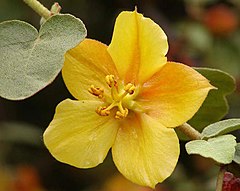Fremontodendron
| Fremontodendron {{{latin_name}}}
|
flannelbush, flannel bush
| ||||||||||||||||||||||||||||||||||||||||
|---|---|---|---|---|---|---|---|---|---|---|---|---|---|---|---|---|---|---|---|---|---|---|---|---|---|---|---|---|---|---|---|---|---|---|---|---|---|---|---|---|---|

|
|
| |||||||||||||||||||||||||||||||||||||||
| |||||||||||||||||||||||||||||||||||||||||
| Standard Cyclopedia of Horticulture |
|---|
|
Freemontia (after John Charles Fremont, distinguished western explorer, who discovered it in 1846). Syn. Fremontodendron. Sterculiaceae. Ornamental woody plant, grown chiefly for its showy yellow flowers. Deciduous shrub or small tree with stellate pubescence: lvs. alternate, slender-petioled, palmately lobed: fls. solitary on short, lateral brancnlets, apetalous; calyx large, deeply 5-parted, with 3 small bracts at the base; stamens 5, connate toward the base into a tube; ovary superior, inclosed by the staminal tube; style filiform: fr. a 5-celled, hirsute, dehiscent caps, with many seeds.—One species in Calif., allied to the Mexican Cheiranthodendron. Its bark is sometimes used as a substitute for that of the slippery elm and the plant is therefore locally known under this name. This is a beautiful free-flowering shrub, with rather small, palmately lobed leaves and large yellow flowers appearing in great profusion in June. It is not hardy North, and in cooler regions it should have a sunny and sheltered position, preferably against a wall of southern aspect; it prefers well-drained, rather dry soil, and dislikes, especially during the winter, an excess of moisture. Propagation is by seeds or by greenwood cuttings under glass in summer. CH
|
Cultivation
- Do you have cultivation info on this plant? Edit this section!
Propagation
- Do you have propagation info on this plant? Edit this section!
Pests and diseases
- Do you have pest and disease info on this plant? Edit this section!
Species
There are two species: the California Flannelbush F. californicum, and the Mexican Flannelbush F. mexicanum, and a number of populations of uncertain statuswp. In addition, a number of hybrid cultivars have been produced, including 'California Glory', 'Ken Taylor', and 'Pacific Sunset'wp.
Gallery
If you have a photo of this plant, please upload it! Plus, there may be other photos available for you to add.
References
- Standard Cyclopedia of Horticulture, by L. H. Bailey, MacMillan Co., 1963
External links
- w:Fremontodendron. Some of the material on this page may be from Wikipedia, under the Creative Commons license.
- Fremontodendron QR Code (Size 50, 100, 200, 500)
